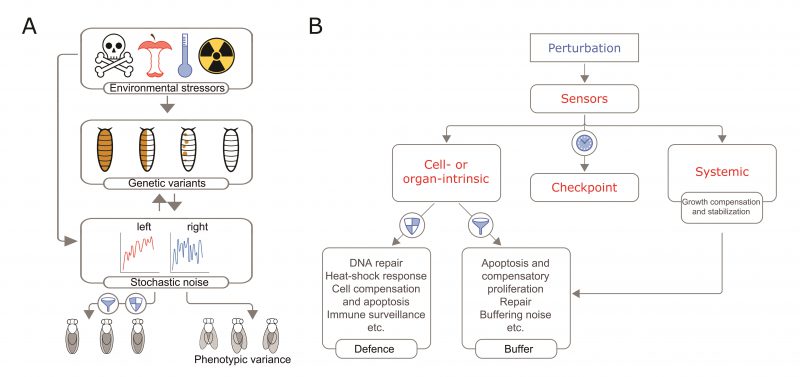Back to article: Systemic signalling and local effectors in developmental stability, body symmetry, and size
FIGURE 1: A speculative model of the three sources of perturbation and their interactions in generating intra- and interindividual phenotypic variability, illustrated in flies. (A) Drosophila larvae may acquire mutations that can be expressed in a mosaic state (brown dots) or inherited from one of the parents (all brown). Stochastic noise may cause gene expression fluctuations and variability in growth between the left and right sides. Environmental factors may cause changes in gene expression by genetic and non-genetic effects. Biological noise can cause replication errors that result in mutations e.g. [61] and thus it may also contribute to somatic mutations. (B) Developmental robustness requires mechanisms that sense damage and growth perturbations inflicted at the cell, organ, and systemic level. Specific damage sensors activate coordinated responses that trigger checkpoints such as transcriptional or cell cycle arrest to provide time for repair or to counterbalance perturbations (e.g., during a thermal stress). When damage is unrepairable, cellular stress sensors also initiates the apoptosis of the damaged cells. To maintain tissue growth and homeostasis, stress sensors such as p53 trigger compensatory proliferation. Massive tissue damage activates local regenerative responses and trigger a checkpoint that delays developmental timing (maturation) and act systemically. In addition, a variety of surveillance mechanisms maintain tissue quality control by detecting and eliminating both less fit and potentially harmful cells.
61. Uphoff S, Lord ND, Okumus B, Potvin-Trottier L, Sherratt DJ, and Paulsson J (2016). Stochastic activation of a DNA damage response causes cell-to-cell mutation rate variation. Science 351(6277): 1094–1097. doi: 10.1126/science.aac9786

